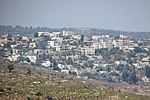Bani Zeid al-Sharqiya
Bani Zeid al-SharqiyaMunicipalities of the State of PalestineRamallah and al-Bireh GovernorateTowns in the West BankVague or ambiguous time from November 2012

Bani Zeid al-Sharqiya (Arabic: بني زيد الشرقية) is a Palestinian town in the northern West Bank, located north of Ramallah in the Ramallah and al-Bireh Governorate. It was formed as a result of a merger of the villages of 'Arura, Mazari al-Nubani, and Abwein, although the latter separated from the municipality. Bani Zeid al-Sharqiya is 3 kilometers (1.9 mi) north of Ajjul and other nearby localities include Deir as-Sudan to the southeast, Kafr Ein to the east, and Abwein to the southwest.
Excerpt from the Wikipedia article Bani Zeid al-Sharqiya (License: CC BY-SA 3.0, Authors, Images).Bani Zeid al-Sharqiya
Geographical coordinates (GPS) Address Nearby Places Show on map
Geographical coordinates (GPS)
| Latitude | Longitude |
|---|---|
| N 32.033333333333 ° | E 35.166666666667 ° |
Address
390
Palestinian Territories
Open on Google Maps







